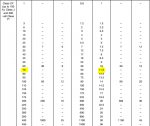BN32
Member
- Location
- Chicago, IL
- Occupation
- Design
I need to achieve a 65kA overall panel rating but am starting to think that may not be possible if I'm understanding the 508A standard correctly.
Is my panel SCCR rating limited to the 5kA rating of the AC unit since the peak let through current for a 70A class J fuse @ 100kA (11.5kA) is greater than 5kA?
All the other branches are 65kA or greater this was my weak link.
See details below.
Main panel disconnect fusing: LPJ-70SP - 300kA Vac RMS Sym.
AC Unit branch circuit protection: 140M-C2E-C10 - 65kA @ 480Y/277V
AC Unit: Rittal 5kA


Is my panel SCCR rating limited to the 5kA rating of the AC unit since the peak let through current for a 70A class J fuse @ 100kA (11.5kA) is greater than 5kA?
All the other branches are 65kA or greater this was my weak link.
See details below.
Main panel disconnect fusing: LPJ-70SP - 300kA Vac RMS Sym.
AC Unit branch circuit protection: 140M-C2E-C10 - 65kA @ 480Y/277V
AC Unit: Rittal 5kA



